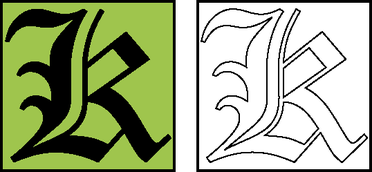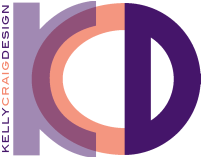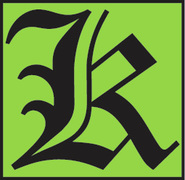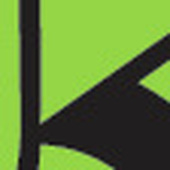All digital art is a raster file. Or a vector file. One or the other. And really, you can have an image that combines a raster file AND a vector file. But what does this mean? And how does this impact you when you're working with a designer?
A raster file is made up of pixels. Lots and lots of them. Photographs are raster files. If the file was created in a program like Photoshop, its a raster file. Raster file types include psd, tif, jpg, png, and gif. It looks like this:
A vector file is created with lines. Outlines of shapes form the images. They can be straight or curved, filled in or just lines. A vector file would be drawn or traced in a drawing program, like Illustrator. Vector files include ai, pdf, and eps. It looks like this:

The black and white shows the outlines that create this file. I could enlarge this over and over and over and it would still be a crisp clean line drawing.
Why do you need to know this? Let's say you have a designer create a logo for you and you want to put it on a website, a business card, a T-shirt, ball point pens… these don't all need the same file type. I get many requests to have logos that were drawn by someone else changed into other file types to use in different applications than what they were intended for. I will get a jpg file of a company's logo. It's made up of tiny little pixels. They would like their logo printed onto golf balls to use at a tournament and the printing company would like it all in outlines (vector file). That jpg isn't going to work. Ever.
Sometimes this is quick, easy and painless. Other times, it's very time consuming and can get expensive. Going from a line drawing (vector file) to a pixelated image (raster) is usually easy and inexpensive. Going from a raster file to a vector file demands a trace (which is usually not very precise) or a complete redraw. It can cost a lot of money. In some cases, it's impossible.
Some images cannot be interchanged. For example, a photograph cannot be a vector file. It just can't. Photos are made up of lots of little pixels and when viewed all together, make the image. You just can't draw that. And you also can't make a die-cut vinyl out of it, or send that image to a merchandising company to print your logo on a golf ball.
When working with a designer, be sure to talk to them about how the art is being created, and what it can be used for. Discuss this in the planning phase, so that when you get the files, they're exactly what you need. And try to plan for every possible use for your images up front. It's much easier, and affordable, to get them in the right format in the first place than to have to have them redone for different uses down the road!
Sometimes this is quick, easy and painless. Other times, it's very time consuming and can get expensive. Going from a line drawing (vector file) to a pixelated image (raster) is usually easy and inexpensive. Going from a raster file to a vector file demands a trace (which is usually not very precise) or a complete redraw. It can cost a lot of money. In some cases, it's impossible.
Some images cannot be interchanged. For example, a photograph cannot be a vector file. It just can't. Photos are made up of lots of little pixels and when viewed all together, make the image. You just can't draw that. And you also can't make a die-cut vinyl out of it, or send that image to a merchandising company to print your logo on a golf ball.
When working with a designer, be sure to talk to them about how the art is being created, and what it can be used for. Discuss this in the planning phase, so that when you get the files, they're exactly what you need. And try to plan for every possible use for your images up front. It's much easier, and affordable, to get them in the right format in the first place than to have to have them redone for different uses down the road!



 RSS Feed
RSS Feed